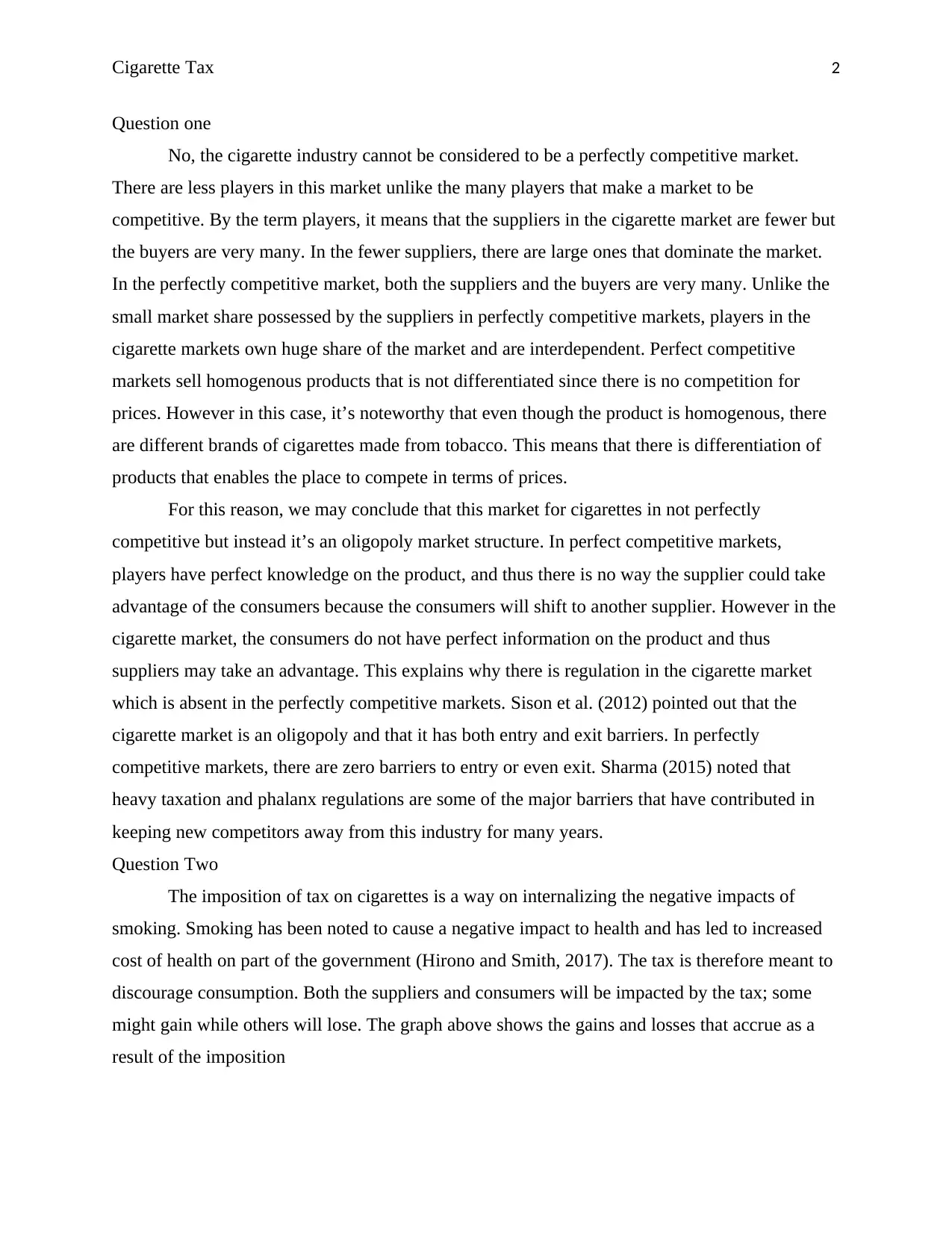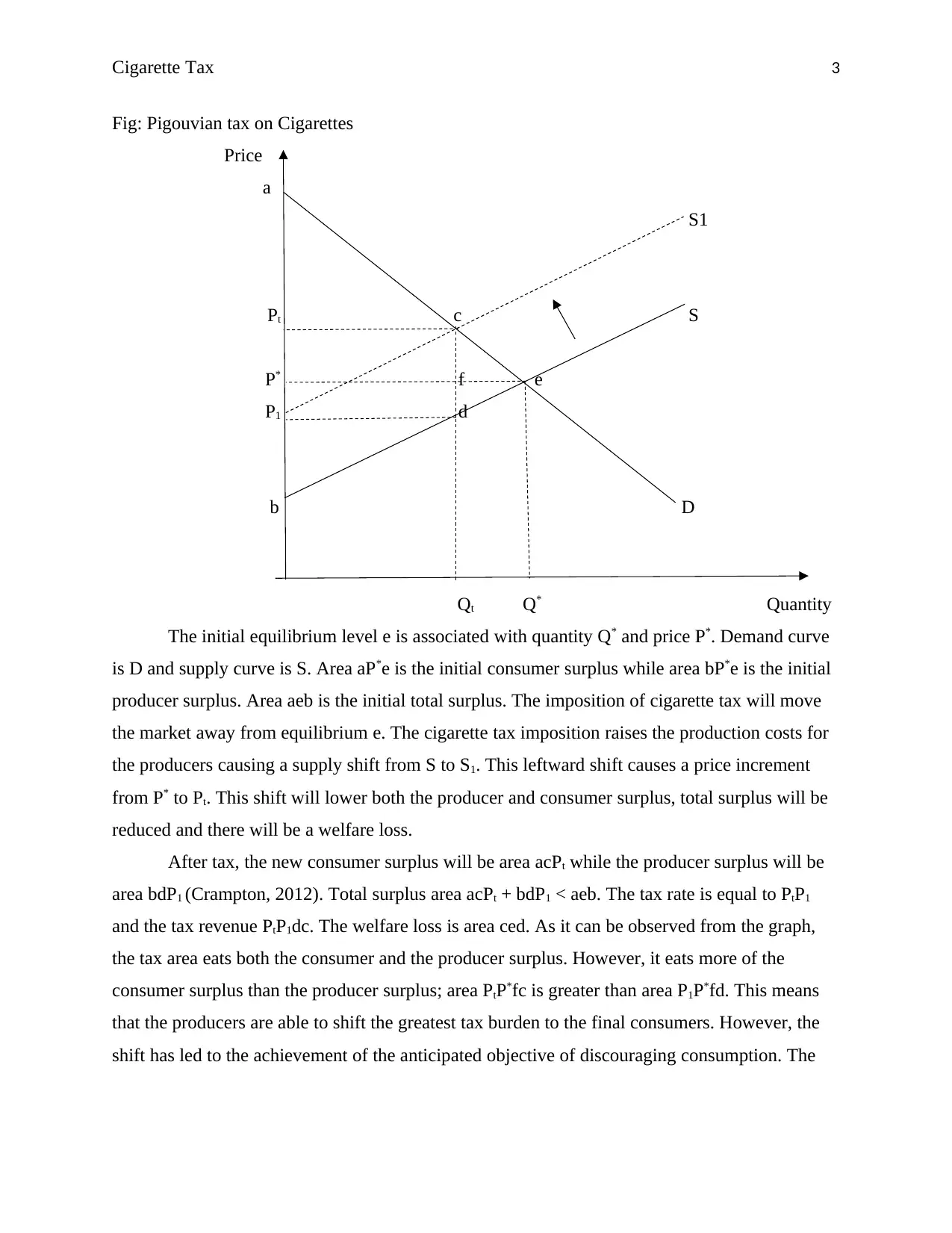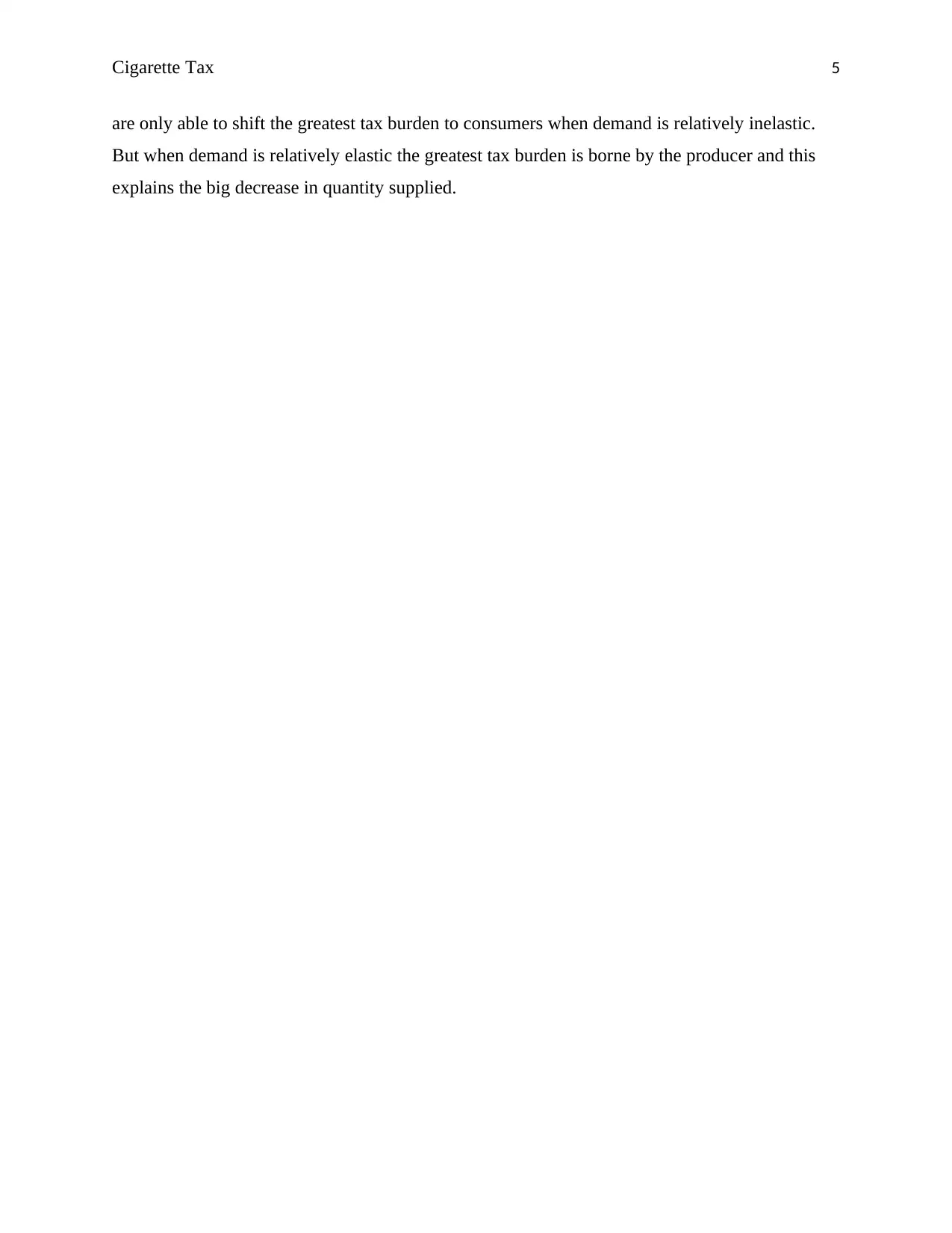BUS502 Economics: Cigarette Tax, Market Structure and Implications
VerifiedAdded on 2023/06/13
|6
|1362
|122
Report
AI Summary
This report analyzes the cigarette market, determining it to be an oligopoly rather than a perfectly competitive market due to factors like fewer suppliers, product differentiation, and imperfect consumer knowledge. It examines the impact of cigarette taxes using supply and demand diagrams, illustrating shifts in surplus and welfare loss, noting that the tax burden disproportionately affects consumers. The report also addresses the argument against cigarette taxes, particularly their effect on low-income earners, discussing the inelastic demand for cigarettes and the limitations of using taxes to discourage consumption due to equity concerns. The report references several sources to support its analysis of the cigarette market and the effects of taxation.

Running Head: Cigarette Tax
NAME:
ID NO:
Tutor’s name:
ATMC BUS502 Principles of Economics for Accountants – Semester One 2018
Assessment task 2 – Responses to articles - Article 2
(Date)
NAME:
ID NO:
Tutor’s name:
ATMC BUS502 Principles of Economics for Accountants – Semester One 2018
Assessment task 2 – Responses to articles - Article 2
(Date)
Paraphrase This Document
Need a fresh take? Get an instant paraphrase of this document with our AI Paraphraser

Cigarette Tax 2
Question one
No, the cigarette industry cannot be considered to be a perfectly competitive market.
There are less players in this market unlike the many players that make a market to be
competitive. By the term players, it means that the suppliers in the cigarette market are fewer but
the buyers are very many. In the fewer suppliers, there are large ones that dominate the market.
In the perfectly competitive market, both the suppliers and the buyers are very many. Unlike the
small market share possessed by the suppliers in perfectly competitive markets, players in the
cigarette markets own huge share of the market and are interdependent. Perfect competitive
markets sell homogenous products that is not differentiated since there is no competition for
prices. However in this case, it’s noteworthy that even though the product is homogenous, there
are different brands of cigarettes made from tobacco. This means that there is differentiation of
products that enables the place to compete in terms of prices.
For this reason, we may conclude that this market for cigarettes in not perfectly
competitive but instead it’s an oligopoly market structure. In perfect competitive markets,
players have perfect knowledge on the product, and thus there is no way the supplier could take
advantage of the consumers because the consumers will shift to another supplier. However in the
cigarette market, the consumers do not have perfect information on the product and thus
suppliers may take an advantage. This explains why there is regulation in the cigarette market
which is absent in the perfectly competitive markets. Sison et al. (2012) pointed out that the
cigarette market is an oligopoly and that it has both entry and exit barriers. In perfectly
competitive markets, there are zero barriers to entry or even exit. Sharma (2015) noted that
heavy taxation and phalanx regulations are some of the major barriers that have contributed in
keeping new competitors away from this industry for many years.
Question Two
The imposition of tax on cigarettes is a way on internalizing the negative impacts of
smoking. Smoking has been noted to cause a negative impact to health and has led to increased
cost of health on part of the government (Hirono and Smith, 2017). The tax is therefore meant to
discourage consumption. Both the suppliers and consumers will be impacted by the tax; some
might gain while others will lose. The graph above shows the gains and losses that accrue as a
result of the imposition
Question one
No, the cigarette industry cannot be considered to be a perfectly competitive market.
There are less players in this market unlike the many players that make a market to be
competitive. By the term players, it means that the suppliers in the cigarette market are fewer but
the buyers are very many. In the fewer suppliers, there are large ones that dominate the market.
In the perfectly competitive market, both the suppliers and the buyers are very many. Unlike the
small market share possessed by the suppliers in perfectly competitive markets, players in the
cigarette markets own huge share of the market and are interdependent. Perfect competitive
markets sell homogenous products that is not differentiated since there is no competition for
prices. However in this case, it’s noteworthy that even though the product is homogenous, there
are different brands of cigarettes made from tobacco. This means that there is differentiation of
products that enables the place to compete in terms of prices.
For this reason, we may conclude that this market for cigarettes in not perfectly
competitive but instead it’s an oligopoly market structure. In perfect competitive markets,
players have perfect knowledge on the product, and thus there is no way the supplier could take
advantage of the consumers because the consumers will shift to another supplier. However in the
cigarette market, the consumers do not have perfect information on the product and thus
suppliers may take an advantage. This explains why there is regulation in the cigarette market
which is absent in the perfectly competitive markets. Sison et al. (2012) pointed out that the
cigarette market is an oligopoly and that it has both entry and exit barriers. In perfectly
competitive markets, there are zero barriers to entry or even exit. Sharma (2015) noted that
heavy taxation and phalanx regulations are some of the major barriers that have contributed in
keeping new competitors away from this industry for many years.
Question Two
The imposition of tax on cigarettes is a way on internalizing the negative impacts of
smoking. Smoking has been noted to cause a negative impact to health and has led to increased
cost of health on part of the government (Hirono and Smith, 2017). The tax is therefore meant to
discourage consumption. Both the suppliers and consumers will be impacted by the tax; some
might gain while others will lose. The graph above shows the gains and losses that accrue as a
result of the imposition

Cigarette Tax 3
Fig: Pigouvian tax on Cigarettes
Price
a
S1
Pt c S
P* f e
P1 d
b D
Qt Q* Quantity
The initial equilibrium level e is associated with quantity Q* and price P*. Demand curve
is D and supply curve is S. Area aP*e is the initial consumer surplus while area bP*e is the initial
producer surplus. Area aeb is the initial total surplus. The imposition of cigarette tax will move
the market away from equilibrium e. The cigarette tax imposition raises the production costs for
the producers causing a supply shift from S to S1. This leftward shift causes a price increment
from P* to Pt. This shift will lower both the producer and consumer surplus, total surplus will be
reduced and there will be a welfare loss.
After tax, the new consumer surplus will be area acPt while the producer surplus will be
area bdP1 (Crampton, 2012). Total surplus area acPt + bdP1 < aeb. The tax rate is equal to PtP1
and the tax revenue PtP1dc. The welfare loss is area ced. As it can be observed from the graph,
the tax area eats both the consumer and the producer surplus. However, it eats more of the
consumer surplus than the producer surplus; area PtP*fc is greater than area P1P*fd. This means
that the producers are able to shift the greatest tax burden to the final consumers. However, the
shift has led to the achievement of the anticipated objective of discouraging consumption. The
Fig: Pigouvian tax on Cigarettes
Price
a
S1
Pt c S
P* f e
P1 d
b D
Qt Q* Quantity
The initial equilibrium level e is associated with quantity Q* and price P*. Demand curve
is D and supply curve is S. Area aP*e is the initial consumer surplus while area bP*e is the initial
producer surplus. Area aeb is the initial total surplus. The imposition of cigarette tax will move
the market away from equilibrium e. The cigarette tax imposition raises the production costs for
the producers causing a supply shift from S to S1. This leftward shift causes a price increment
from P* to Pt. This shift will lower both the producer and consumer surplus, total surplus will be
reduced and there will be a welfare loss.
After tax, the new consumer surplus will be area acPt while the producer surplus will be
area bdP1 (Crampton, 2012). Total surplus area acPt + bdP1 < aeb. The tax rate is equal to PtP1
and the tax revenue PtP1dc. The welfare loss is area ced. As it can be observed from the graph,
the tax area eats both the consumer and the producer surplus. However, it eats more of the
consumer surplus than the producer surplus; area PtP*fc is greater than area P1P*fd. This means
that the producers are able to shift the greatest tax burden to the final consumers. However, the
shift has led to the achievement of the anticipated objective of discouraging consumption. The
⊘ This is a preview!⊘
Do you want full access?
Subscribe today to unlock all pages.

Trusted by 1+ million students worldwide

Cigarette Tax 4
quantity level fell from Q* to Q1. The new equilibrium point will be at c where the corresponding
quantity Q1 is supplied at price Pt.
Question Three
This article is arguing against the imposition of the cigarette tax with a claim that it
lowers the consumer’s standard of living especially the low income earners. The article notes
that low income earners do not respond much to lowering their consumption after the price
increment. This argument is based on the concept of elasticity that determines how consumers
behave after a price change. Cigarettes are very addictive and thus tend to have an inelastic
demand meaning that a price rise does not have a significant impact on the level of demand
Fig: Impacts of cigarette smoking when demand is relatively inelastic and relatively elastic
(a) Relatively Inelastic (b) Relatively Elastic
S1 S1
P P
S S
P1 e e
P1
P* P*
D
D
Q1 Q* Q Q1 Q* Q
The cigarette tax causes supply to shift from S to S1 causing price to rise from
equilibrium P* to P1. Equilibrium quantity falls in both cases from Q* to Q1. However, the rise in
price on case (a) where demand is relatively inelastic cause a very small fall in demand. On the
other side, a small price increment for case (b) where demand is relatively elastic causes a very
big decrease in the demanded quantity. Cigarette smoking in the real sense falls under case (a).
Thus, it would take a very big price rise to encourage consumers to lower their level of smoking.
This would require a bigger tax increment which is not applicable because of equity issues. The
equilibrium level ‘e’ in case (a) moves up higher than in case (b). Thus, the price increment
when demand is relatively inelastic is higher than when demand is relatively elastic. Producers
quantity level fell from Q* to Q1. The new equilibrium point will be at c where the corresponding
quantity Q1 is supplied at price Pt.
Question Three
This article is arguing against the imposition of the cigarette tax with a claim that it
lowers the consumer’s standard of living especially the low income earners. The article notes
that low income earners do not respond much to lowering their consumption after the price
increment. This argument is based on the concept of elasticity that determines how consumers
behave after a price change. Cigarettes are very addictive and thus tend to have an inelastic
demand meaning that a price rise does not have a significant impact on the level of demand
Fig: Impacts of cigarette smoking when demand is relatively inelastic and relatively elastic
(a) Relatively Inelastic (b) Relatively Elastic
S1 S1
P P
S S
P1 e e
P1
P* P*
D
D
Q1 Q* Q Q1 Q* Q
The cigarette tax causes supply to shift from S to S1 causing price to rise from
equilibrium P* to P1. Equilibrium quantity falls in both cases from Q* to Q1. However, the rise in
price on case (a) where demand is relatively inelastic cause a very small fall in demand. On the
other side, a small price increment for case (b) where demand is relatively elastic causes a very
big decrease in the demanded quantity. Cigarette smoking in the real sense falls under case (a).
Thus, it would take a very big price rise to encourage consumers to lower their level of smoking.
This would require a bigger tax increment which is not applicable because of equity issues. The
equilibrium level ‘e’ in case (a) moves up higher than in case (b). Thus, the price increment
when demand is relatively inelastic is higher than when demand is relatively elastic. Producers
Paraphrase This Document
Need a fresh take? Get an instant paraphrase of this document with our AI Paraphraser

Cigarette Tax 5
are only able to shift the greatest tax burden to consumers when demand is relatively inelastic.
But when demand is relatively elastic the greatest tax burden is borne by the producer and this
explains the big decrease in quantity supplied.
are only able to shift the greatest tax burden to consumers when demand is relatively inelastic.
But when demand is relatively elastic the greatest tax burden is borne by the producer and this
explains the big decrease in quantity supplied.

Cigarette Tax 6
References
Crampton, E. (2012). Good graphs are general, or how a carbon tax is like drug legalization.
[Online] Offsettingbehaviour.blogspot.com. Available at:
https://offsettingbehaviour.blogspot.com/2012/10/good-graphs-are-general-or-how-carbon.html
[Accessed 6 May 2018].
Hirono, K. and Smith, K. (2017). Tobacco tax hikes are great, so long as you’re not a poor
smoker. [Online] The Conversation. Available at: https://theconversation.com/tobacco-tax-hikes-
are-great-so-long-as-youre-not-a-poor-smoker-75211 [Accessed 6 May 2018].
Sharma, R. (2015). 3 Reasons Why Tobacco Is the Most ‘Successful’ Industry in History.
[Online] The Cheat Sheet. Available at: https://www.cheatsheet.com/money-career/3-reasons-
why-tobacco-is-the-most-successful-industry-in-history.html/?a=viewall [Accessed 6 May
2018].
Sison, Serrano, Valmores, Villa-Real, Villarico and Wongchuking (2012). The Tobacco-
Cigarette Industry: An Oligopoly Market Structure. [Online] prezi.com. Available at:
https://prezi.com/xwcvamkhev3d/the-tobacco-cigarette-industry-an-oligopoly-market-structure/
[Accessed 6 May 2018].
References
Crampton, E. (2012). Good graphs are general, or how a carbon tax is like drug legalization.
[Online] Offsettingbehaviour.blogspot.com. Available at:
https://offsettingbehaviour.blogspot.com/2012/10/good-graphs-are-general-or-how-carbon.html
[Accessed 6 May 2018].
Hirono, K. and Smith, K. (2017). Tobacco tax hikes are great, so long as you’re not a poor
smoker. [Online] The Conversation. Available at: https://theconversation.com/tobacco-tax-hikes-
are-great-so-long-as-youre-not-a-poor-smoker-75211 [Accessed 6 May 2018].
Sharma, R. (2015). 3 Reasons Why Tobacco Is the Most ‘Successful’ Industry in History.
[Online] The Cheat Sheet. Available at: https://www.cheatsheet.com/money-career/3-reasons-
why-tobacco-is-the-most-successful-industry-in-history.html/?a=viewall [Accessed 6 May
2018].
Sison, Serrano, Valmores, Villa-Real, Villarico and Wongchuking (2012). The Tobacco-
Cigarette Industry: An Oligopoly Market Structure. [Online] prezi.com. Available at:
https://prezi.com/xwcvamkhev3d/the-tobacco-cigarette-industry-an-oligopoly-market-structure/
[Accessed 6 May 2018].
⊘ This is a preview!⊘
Do you want full access?
Subscribe today to unlock all pages.

Trusted by 1+ million students worldwide
1 out of 6
Related Documents
Your All-in-One AI-Powered Toolkit for Academic Success.
+13062052269
info@desklib.com
Available 24*7 on WhatsApp / Email
![[object Object]](/_next/static/media/star-bottom.7253800d.svg)
Unlock your academic potential
Copyright © 2020–2025 A2Z Services. All Rights Reserved. Developed and managed by ZUCOL.





